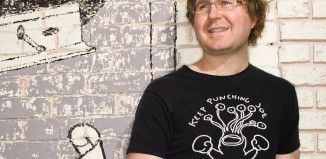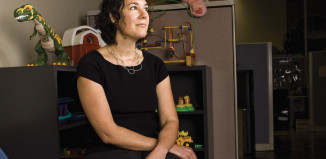When Carlos Carter walks in the room, you know it. He is soft-spoken, but the affection the Project Transitions staff have for him is tremendous. They emerge from offices and cubicles to give hugs and catch up, the gleams in their eyes like that of proud parents.
They have good reason to be proud. In the year that he has been living in the agency’s residences, he’s accomplished a lot.
Carter first came to Project Transitions a year ago after ending up in the emergency room with a colon infection. He already knew he had HIV (he was diagnosed in 2008), but because of a high t-cell count, he hasn’t had to be on a regimen of drugs for that disease. He was, however, supposed to be on medications for psychological issues and has a background as an on-again, off-again drug user.
After landing in the hospital, Carter knew that returning to his previous apartment would lead him back into drug use. His primary-care doctor suggested Doug’s House, Project Transitions’ residential hospice, as a place to rest and recuperate.
“I thought of (it as a) hospice, but he said I could go there for rest,” Carter said. “The nurses there helped me get back on medication and get back with doctors.”
From Doug’s House, he transitioned to another Project Transitions residential facility, Roosevelt Gardens, where he lives now.
Project Transitions provides hospice, housing and support for people in Austin living with HIV and AIDS. The organization started in 1986 when founder Barbara Davis saw the need for a compassionate residential facility where people with AIDS could die with dignity. Nearly three decades later, the organization includes residential hospice and three transitional housing programs. It also helps everyone from single people to families with young children.
“I’m back to seeing a doctor, back on psych meds, back on one-on-one counseling,” Carter said. “When I was in my old apartment, I was very isolated, and now I’m back mixing and mingling. I’m in a positive environment—everyone there is HIV positive, and I have no problem talking to my neighbor. Where I used to be, no one knew my status. I wasn’t able to talk to anyone. I’d cut myself off from my family…when I was using, my mind was clouded, bouncing everywhere. It was all about the drugs. Today it’s about Carlos, trying to keep Carlos together.”
When Carter learned he was HIV positive, it didn’t come as a shock. Three of his brothers and several close friends had already passed away from AIDS, so when it became hard for him to swallow even water without pain, he called his sister. She urged him to come home and get tested.
“[The health care worker] set the test on the table, and the two red lines popped up. He immediately looked at me, but I wasn’t shocked. I wasn’t angry with anyone or anything—I kind of already knew because I’d been having unprotected sex for so many years,” Carter said. “And doing drugs. I wasn’t using condoms or anything. Some of my friends had passed on, and we’d been with the same guys. It wasn’t a big shock to me. I was mostly worried about going home and telling my family.”
Carter had met the close friends he’s lost in church and shared a very religious background with them. All were young, and in the early days of HIV, it was easier to be in denial, he observed, especially with strict parents. He came out, unintentionally, to his parents at age 18, when his mother overheard him talking on the phone.
While she initially had a hard time accepting that he was gay, Carter’s father stood up for him. Today he feels a great deal of support from both his family and his church community, even though he knows some still have a hard time accepting homosexuality.
“My mom was in a great deal of denial,” Carter said of his own coming out. “It took her a long time to get over it. I believe we [the group of friends] bonded because we were all in church together.”
Being able to have a safe place to live where he can meet regularly with a case manager and attend classes has helped him get to a healthier place, he acknowledged. He’s now helping others too, doing volunteer work in the community through the Austin Area Comprehensive HIV Planning Council.
The journey that Carter has taken through Project Transitions is typical of the kind of care its residents receive, said Elaine Holton, the organization’s volunteer coordinator. Doug’s House gave him a chance to reconnect to mental health, social, and physical services, and he’s been able to continue receiving that support at Roosevelt Gardens. Eventually Carter will transition into public housing and live on his own.
While they live at one of the Project Transitions housing programs, the residents make it their own community, Holton continued. The organization’s staff is there to provide support, but it’s the residents who hold town hall meetings and create the dynamics of the community. Depending on who’s living in the residences, that community can include a wide variety of people from all walks of life: from families with young children to individuals who have been homeless for the past several decades and are now living in an apartment for the first time.
Project Transitions also works closely with several other organizations in Austin that provide support for residents, including AIDS Services of Austin, Wright House, and Community AIDS Resources and Education.
“It’s a beautiful journey to see them grow, become the individual they were before,” Holton said of the people Project Transitions works with. “I feel that is our responsibility…we will always be there for them when they are ready. And we do have people who come back into our program, and we welcome them with open arms.”



































